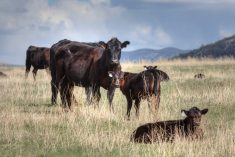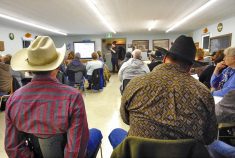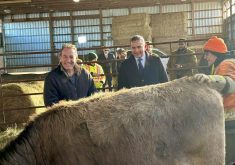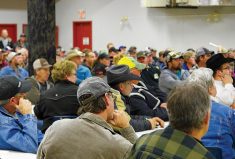Crown land leaseholders say they’re cautiously optimistic about a joint federal-provincial pilot meant to bolster carrying capacity on their leased grazing land.
The one-year Agricultural Crown Lands Forage Productivity Pilot Program will be funding 42 projects, a joint government release said April 22.
Under the program, projects such as increased water infrastructure, bush management, seeding, cross-fencing or grazing plan development could apply for up to $30,000 in funding. Producers are responsible for 25 per cent of project costs, with government footing the remaining 75 per cent.
Read Also
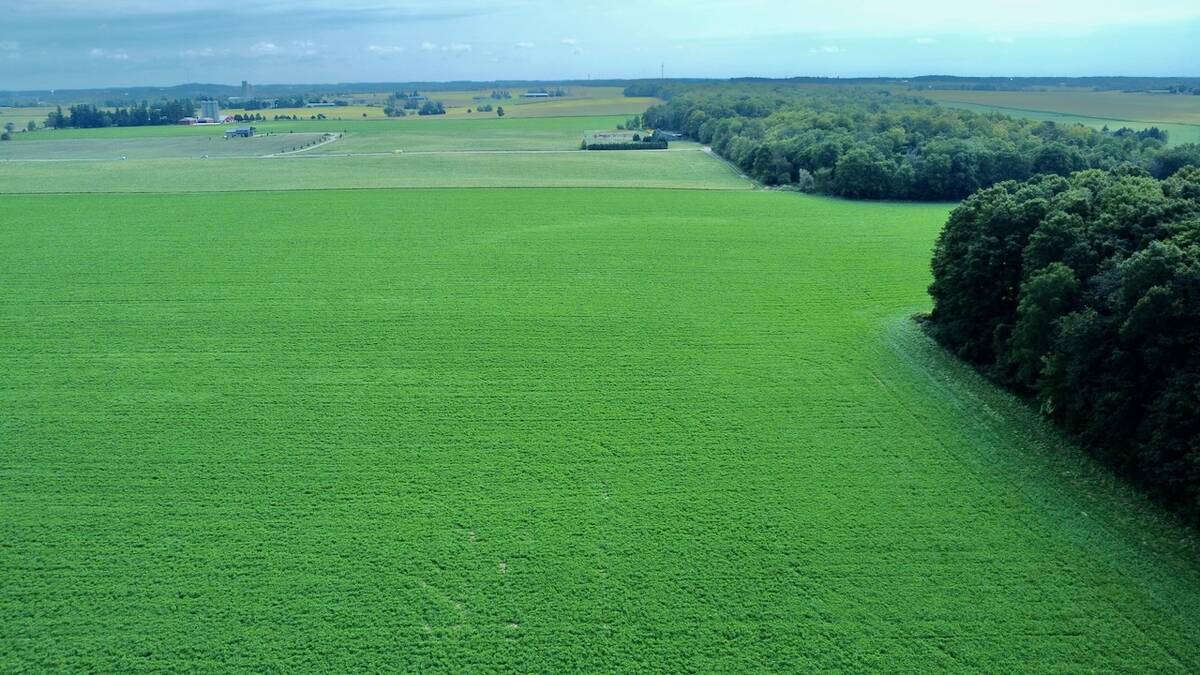
Farm resilience pilot projects launched
The Canadian Alliance for Net Zero Agri-Food (CANZA) aims to reduce farmer risk for adopting sustainable farm practices with projects outlined Oct. 7.
Brent Benson, president of the Manitoba Crown Land Leaseholders Association, said the pilot will likely help “legacy” leaseholders (leases that predate regulation shifts in 2019) restore production in areas starting to grow wild.
Such parcels have caused deep grumblings around rental rates, he said, arguing that the calculation has relied on AUMs (available forage as measured by how much one animal needs per month) that were established decades ago when that land was more productive.
- Letters: Ag minister should honour Crown lands promise
- Letters: Crown land pain continues
- Letters: Manitoba government squeezing ranchers out
“We’re kind of optimistic about that part, but we’re a little cautious because many members are still mistrustful of the government due to the changes the last time they were dealing with Crown land,” Benson said.
Why it matters: The project aims to increase capacity on reduced-productivity Crown land, but previous regulatory changes from 2019 have left a lingering bad taste in many leaseholders’ mouths.
Manitoba Ag Minister Derek Johnson, meanwhile, has said that the program will allow producers to take advantage of greater production, without having greater AUMs applied to their rental formula for the next five years.
“The goal of this pilot project is to make the land more climate resilient and more versatile, (and) obviously increase the carrying capacity, and the uptake was outstanding,” he said. “I’m excited to see the results of this program.”
According to the province, 50 applications were submitted.
Drought recovery
Potential projects could be linked to drought recovery, according to Manitoba Beef Producers (MBP) general manager Carson Callum.
Crown land-heavy areas, such as the northern Interlake, were also among the hardest-hit regions of the 2021 drought. The drought, which made international headlines, led to significantly reduced herd sizes and pasture stress.
“Anything to improve the forage capacity is really important, whether that be on private land or public land, such as these Crown land leases,” Callum said. “It is important to improve that capacity to bounce back from these drought conditions.”
Regardless of other industry concerns around Crown land management, he said, the program is a means to provide drought-hit producers with financial help.
Benson, however, is more dubious.
While AgriRecovery aid programs helped prevent farms in the area from going out of business, Benson argued that the hardest-hit producers did not have enough money to apply, even at a quarter of project costs.
“That’s a concern that I’ve heard from a lot of members, that they were interested in the program to see what it was going to be like, but they didn’t have any cash left,” he said.
For those who could budget for it, Benson said resiliency against drought, as well as the more distant memory of flooding several years ago, would be top of mind when prioritizing improvements.
The program will “help some producers move toward a permanent solution for our climate swings,” Johnson said. “I think that’s important, that we focus on something that helps us long term as well as short term. Investment in land will help both in times of drought and in times of excess moisture.”
Johnson cited improvements like seeding down riparian areas for both forage and erosion control, use of deep-rooted forage crops and water infrastructure.
Dealing with distrust
The program does not, however, erase standing concerns with Crown lands regulations, both the leaseholders’ association and MBP said.
“The pilot has certain aspects of it that would be beneficial, but there’s still many components within the Crown land lease modernization that is still very concerning,” Callum said.
Regulatory changes in 2019, under then-agriculture minister Ralph Eichler, sparked immediate outrage among existing leaseholders. Among the complaints, leaseholders argued that a shortened lease length — dropped from 50 years to 15 — would threaten the continuity of family farms where the majority of land was held though leases. The government contends shorter leases will make it easier for new producers to enter the industry.
The province later added a right-of-renewal for existing “legacy” leases to address that concern, while new leases under the new system would be held to the 15-year turnover.
Other issues persisted during the tenure of Blaine Pedersen, the next agriculture minister, through Eichler’s return to the portfolio and now into Johnson’s term.
Other complaints include the quick ramp-up of rental fees — sparked by a new market-driven formula that raised rents by several orders of magnitude in the space of two years, after remaining unchanged since 2014 — and the removal of the unit transfer.
Benson also argued that the program would not assuage issues around land improvement valuation, despite providing money for the instalment of improvements. Leaseholders had previously argued that, under the new rules, there was less arbitration on the value of land improvements, making it more difficult for a leaseholder to recoup those costs when the lease turned over.
The pilot’s funding for cross-fencing, for instance, would not cover perimeter fencing, which Benson argues are typically the largest fencing costs for leaseholders.
“In decent land, like a lot of private land that has good forage production on it, you’re cross-fencing quarter sections into smaller pieces,” he said. “Here, you’re cross-fencing sections of land into one or two pieces only, because that’s all that it will hold cattle for, for a couple of weeks, because the productivity is so low.”
Water infrastructure, meanwhile, already had a funding stream through Ag Action Manitoba’s beneficial management practice (BMP) program, he noted.
Johnson, however, argued that, unlike existing BMP funding, the pilot is exclusive to Crown lands.
The leaseholders’ association would also have liked more transparency in how projects were approved, Benson said.
“That part, I think, would go a long ways to alleviate some of our concerns,” Benson said. “Just because, if it helps bring the land back to where it was, then we can justify the high rent on that piece of land. But there’s still lots of pieces of land where the rent is unjustifiably high and the ability to improve it is very low.”
According to the province’s website, applications were assessed on an index gauging environmental benefit, how the project would encourage environmentally and economically sustainable agriculture, and clarity in how the stated outcome would be achieved.
Johnson, meanwhile, said he’s heard “both positive and negative stories from all aspects of ag Crown land” on the modernized system.
“Now that the changes have been made for a few years, it’s time to look at what we got right and also where there might be room for improvement,” he said.
He pointed to an MLA committee that has been charged with gathering leaseholder feedback, as well as consultation with industry.
MBP said it continues to push Crown land system changes with the province.
“However, this pilot is still providing that financial support to improve the resiliency of these lands,” Callum said. “It’s seen as a benefit, but I think a lot of that benefit is potentially overshadowed in that community.”
Into the future
If all goes well, this is the sort of project MBP might like to see brought over into the next federal-provincial ag policy framework, Callum noted. Industry is expecting the five-year replacement for the current Canadian Agricultural Partnership (CAP) starting in 2023.
“I think there’s going to be opportunities for specific BMPs, similar to (the) previous CAP,” Callum said. “There could be potential to have an agricultural Crown land-specific avenue or funding stream for producers to access.”
Potential changes might include a shift in cost share that “recognizes all the important ecosystem service that those producers are providing to that public land,” he added.
Definite requests would have to wait until MBP sees how current projects progress, he said.
Benson, likewise, sees potential for the next framework, although “tweaking” would be needed.
For example, he noted, he sees little enticement under the current pilot for non-legacy leaseholders, who must periodically compete for their lease.
“You’re basically going to make it more attractive for other people to bid on,” he said. “Yes, you’re getting, say, three-quarters of it this year covered by the government, but it’s still going to make it very hard to keep your farm intact when it comes up for auction again.”
The government will need to see the results of the pilot before deciding if a similar stream can be created in the next framework, Johnson said.






